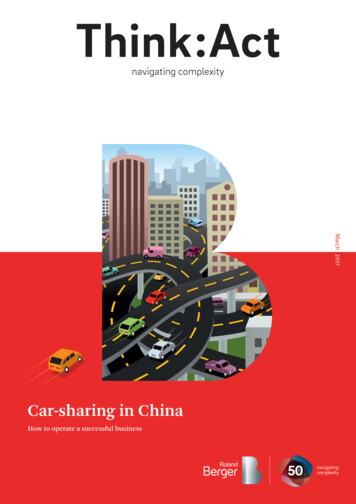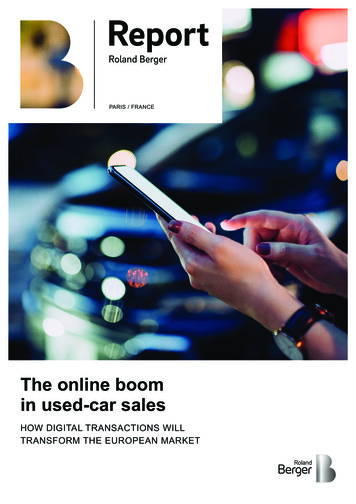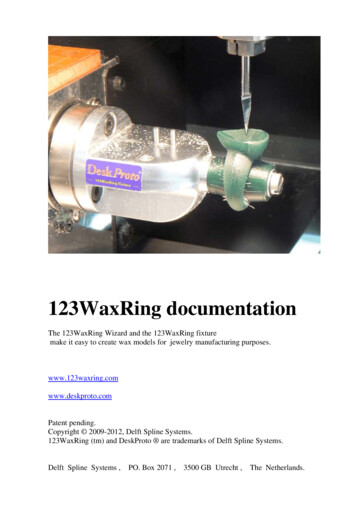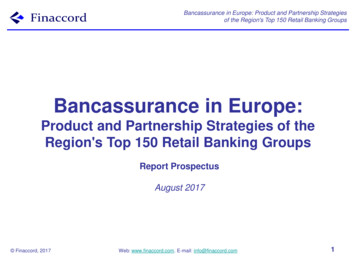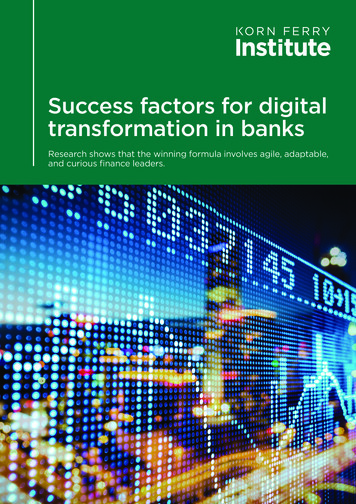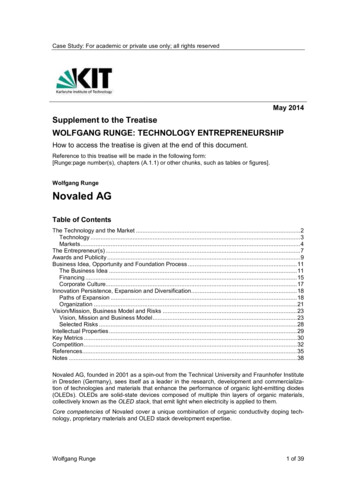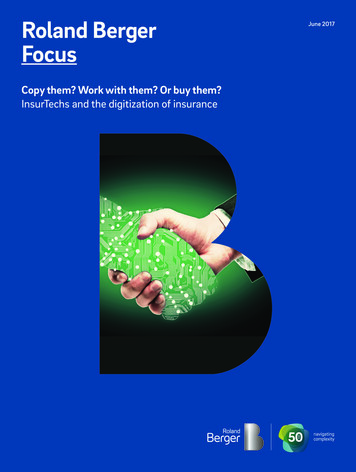
Transcription
June 2017Copy them? Work with them? Or buy them?InsurTechs and the digitization of insurance
2 Roland Berger Focus – Digitization in the insurance industryManagement summaryDo innovative and agile InsurTechs pose an existentialthreat to incumbent insurers? What business models arethe newcomers already applying successfully? Whichones are rapidly approaching market readiness? Andwhich ones have the greatest potential to radically transform the industry?This study explains the most important strategic issuessurrounding digitization in the context of insurance. Italso spells out how incumbent players can maintaintheir competitive edge going forward by drawing ontheir genuine strengths, adopting new business models– or combining the two.This edition of Focus takes an in-depth look at the current InsurTech scene, analyzing its market readinessand innovative potential. The authors argue that although the start-ups with the greatest potential to disrupt the insurance landscape – InsurTechs with a background in artificial intelligence, smart sensors and dataanalytics – are still far from market-ready, the time hasnow come for insurance companies to develop and implement digitization strategies that are tailored to theirown organizations. In the process, they can invest instrengthening existing business models, and they canimprove the customer experience and the efficiency oftheir processes. Alternatively, they can seize the opportunity afforded by applications such as smart analyticsto develop new business models and occupy new ecosystems.Whichever route they take, the time to act is now. AndInsurTechs can play an important part in their realignment – be it as challengers and competitors, as innovative partners or as attractive acquisition targets.InsurTechs can play a valuable role assparring partners in the development ofdigitization strategies. They highlight thedevelopment options open to establishedbusiness models and provide input for freshideas. It must, however, be noted that conditions on both sides vary very considerably.Few success stories can simply be cut andpasted into other contexts.
Digitization in the insurance industry – Roland Berger Focus 3Contents1. Insurance in transition:The role of InsurTechs . 42. The hype surrounding InsurTechs:Market overview. 63. Digital business models:Many roads lead to the same goal . 14Cover photo: iStockphoto / Peshkova4. A window of opportunity:Shaping change now . 18
4 Roland Berger Focus – Digitization in the insurance industrySection 01:Insurance in transition:The role of InsurTechs
Digitization in the insurance industry – Roland Berger Focus 5The changes digitization is bringing to the service sectorcan be likened to the way the Industrial Revolution utterly transformed manufacturing industries in the 19thcentury. One of many areas in which we see this is incustomer expectations – such as when digital natives demand easy access, absolute transparency and the mobileavailability of all relevant data.To find out which technologies and business modelswill shape the insurance landscape in the future andhow digitization is impacting on this industry, RolandBerger investigated 250 InsurTechs around the globe.Workshops with representatives of the health, life andnon-life segments and a thorough analysis of the startup community laid the foundation for Roland Berger'sassessment.In any industry, the emergence of start-ups is a tellingindication that huge changes lie ahead for the valuechain. Since newcomers and old hands alike both wantto take advantage of the resultant opportunities, we alsoexamined those digitization initiatives engaged in by insurers that are common knowledge, grouping them intofour strategic lines of action.Our investigation gave us a comprehensive insight intothe digitization projects of familiar market players andnew arrivals, allowing us to rate them and make recommendations on how insurance companies can advancedigitization on a strategic level.Preview – Three key findings:1 – Start-ups whose offerings are rooted in artificial intelligence (AI), smart sensor InsurTechs and InsurTechsthat concern themselves with data analytics are in possession of technologies that can bring fundamentalchange to the traditional insurance business. All threeonly have isolated applications that are ready to go tomarket. That said, they have tremendous potential forinnovation on a broad scale.2 – It is high time for insurance companies to get seriousabout digitization. As they seek to do so, InsurTechs canserve as useful cooperation partners, role models or acquisition targets. A positive customer experience andseamless, efficient processes will help the developmentof innovative smart analytics business models and newecosystems.3 – Insurers and start-ups are tackling the same issues,but InsurTechs have the advantage of being largely freefrom traditions and legacy structures. They are also acting on the basis of DNA that is digital through andthrough.Roland Berger investigated 250 InsurTechsaround the globe,analyzing them in workshops with representatives of the health, lifeand non-life segments.
6 Roland Berger Focus – Digitization in the insurance industrySection 02:The hype surroundingInsurTechs: Marketoverview
Digitization in the insurance industry – Roland Berger Focus 7For the purposes of this RB Focus edition, Roland Berger investigated 250 international InsurTechs. Thesebreak down into a total of ten clusters across threegroups. AThe market readiness and innovative potential of the250 InsurTechs analyzed were assessed on a scale from1 to 5. One InsurTech has been chosen as an example toillustrate each of the ten clusters. Powerful innovativepotential influences and alters insurers' existing business models. The higher the market readiness and innovative potential scores, the faster incumbent insurersmust review and, where necessary, adapt their businessmodels.DIGITAL CUSTOMER MANAGEMENTCluster 1: Comparison andmanagement platformsComparison platforms present customers with a comprehensive choice of all kinds of insurance. They featurecustomer ratings and an overview of the available insurance policies and coverage elements. Some providershave been on the market for around 20 years, so theseplatforms are comparatively well established.However, they do vary substantially in terms of user-friendliness and customer orientation. Intuitive easeof use and the integration of relevant information relating to insurance are key success factors.Comparison platforms can begin to move forward bygrowing their services in the direction of an integratedcomparison and management platform. For all types ofinsurance, this kind of platforms delivers completetransparency about coverage while allowing policies tobe managed simply and conveniently. Many providerscombine online policy management with the services ofa broker. This approach exposes insurance companies tothe threat of losing direct access to their customers – andhence losing the right to interact with customers direct-ly. Brokers must prepare to face up to new, digital competitors. The scores for this cluster indicate advancedmarket readiness but little innovative potential, as theseInsurTechs fit seamlessly into insurers' existing valuechains.Feelix (www.myfeelix.de) is a German app-based comparison and management platform for insurance, financial investments, loan agreements and real estate. The softwareaggregates financial products and also provides advice. Ifcustomers so desire, it also draws their attention to possi bili ties for optimization, as well as proactively reportingchanges in prices and/or benefits. Feelix provides services toend customers and solutions for brokers.Market readiness: Innovative potential:Cluster 2: Broker solutionsInsurTechs with broker solutions sell software that digitizes brokers' customer management activities. Theymainly support small and midsized brokers who do nothave a proprietary solution with which to design theirprocesses seamlessly and efficiently. Broker solutionsalso give them a quick and convenient way to identifyand process cross-selling opportunities and contractsthat are due to expire. These InsurTechs already operateon the market, but their innovative potential is limitedto digitizing existing processes.Insly (www.insly.com) is a successful InsurTech that hasbeen around for a long time. Originally from Estonia, it isnow domiciled in the UK. Having started life as a spin-offfrom a major broker group, it makes good use of the fact that95% of brokers are small firms. Insly provides user-friendlysoftware that can be integrated in all of a broker's managedinsurance policies, making management much simpler and
8 Roland Berger Focus – Digitization in the insurance industryA: Typology of InsurTechsInsurTech ratings by market readiness and innovative potential.The higher the score, the faster incumbent insurers must adjust.DIGITAL CUSTOMER MANAGEMENT1. Comparison andmanagement platforms2. Broker solutionsINNOVATIVE SERVICES AND PRODUCTS3. Mobility and security4. Health insurance5. Asset protection6. Smart sensors7. Peer-to-peerPROCESS OPTIMIZATION ANDCUSTOMER SELECTION8. Robotic process automation9. Data analytics10. Artificial intelligenceMARKET READINESS1 No established solutions –Solutions under development2 Present with partial solutions/beta versions in initial markets3 Present with mature solutionsin initial markets4 Present in many markets,small market share5 Standard practice in many marketsINNOVATIVE POTENTIAL1 Superior customer experience thanksto digitization of existing businessmodels2 Superior customer experience andsignificant efficiency gains thanks todigitization of existing business models3 Partial redesign of the value chain –Adaptation of existing business modelsrequired4 Partial redesign of the value chain andpartial replacement of existing businessmodels5 Complete redesign of the value chainand replacement of existing businessmodelsSource: Roland Berger
Digitization in the insurance industry – Roland Berger Focus 9more efficient. Its functionality includes CRM, reporting andclaims management.Market readiness: Innovative potential:INNOVATIVE SERVICES AND PRODUCTSDigitization has opened up completely new dimensions in service development. Seizing the opportunity,some start-ups have specialized in convenience andcustomer-oriented products and services in one of thethree branches of insurance. Since they mostly focus onvery specific customer needs, the corresponding clusters are grouped according to these needs.As a rule, InsurTechs in this group are not conventional insurers with underwriters and an actuarial department. Instead, they position themselves as front endswith a focus on service delivery. Those that evolve in thedirection of traditional offerings with their own legalentity also become product providers. In addition,smart sensor InsurTechs and peer-to-peer (P2P) insurers provide new products and services across allbranches of insurance.Cluster 3: Mobility and securityA broad spectrum of digital solutions for mobility andsecurity is already available. Generally speaking, digitization is gaining ground faster in non-life insurancecompanies than in health and life insurers, becausedigitization is bringing fundamental change to the former's products. Developments such as the Internet ofThings, for example, are transforming insurance intoan integral component of companies' security concepts. New providers in the non-life segment handle adecidedly wide range of activities, focusing on customer-oriented on/off insurance coverage that is very easyto activate or deactivate depending on the situation.Some providers have even gone so far as to include fairly new risks such as cyber-security in their portfolio.The mobility and security cluster is very heterogeneous. On the whole, it is comparatively strong in termsof market readiness, while its innovative potential canbe described as mid-table.TROV (USA, www.trov.com) is a non-life on-demand insurer for roughly one million specific products – one example being insurance for mountain bikes. Customers benefitfrom a user-friendly smartphone app that lets them takeout insurance simply by photographing the purchase receipt. Although TROV is currently only available as anapp, via which products can be insured individually, theportfolio is being expanded constantly. All insurance policies that are taken out are stored in the app. Claims canbe reported directly via a chat function and by sending inphotos. TROV also permits micro-duration insurance: policies can be activated or deactivated with a single swipe,limiting insurance coverage to time windows when anacute threat exists.Market readiness: Innovative potential:Cluster 4: Health insuranceInsurTechs in the health segment often score with thesingular convenience of their mobile apps. In many cases, their services extend the value chain beyond the actual insurance business – with functions such as theselection and rating of service providers, or with videoconsultations for medical advice. InsurTechs in thiscluster already have a firm foothold in the English-speaking world. Their innovative potential is moderate due tothe option of vertical integration.
10 Roland Berger Focus – Digitization in the insurance industryZEST Health (www.zesthealth.com) positions itself as asmart health concierge, offering numerous functions relating to health and healthcare. Rather than focusing on insurance, it addresses customers more on the basis of their needsand has the stated aim of keeping things as simple as possible. To do so, ZEST bundles health insurance policies, butalso adds functions such as video consultations, secondopinions and health programs in a single app.Market readiness: Innovative potential:Cluster 5: Asset protectionCompared to other branches of insurance, relatively fewInsurTechs currently operate in the life insurance-basedasset protection segment. Those that do so restrict theirofferings to either customer-oriented digital consultingor models that create incentives for a healthy lifestyle.The latter services are also available from health insurance service and product providers. If the promised dynamic pricing ever actually materializes, however, thatwould hugely add to the pressure on incumbent providers. Until that happens, both market maturity and innovative potential must be regarded as low.Digitization opens up newdimensions. Start-upsscore with convenienceand customer-orientedproducts and services.MyPension was the first InsurTech to hit the German market with fully digital life insurance. Having gone life in fall2016, the start-up cooperates with a financial service provider in the field of asset management and with a life insurer on pricing. myPension's front end is extremely user-centric, featuring simple explanations and playfulelements.Market readiness: Innovative potential:Cluster 6: Smart sensorsSmart sensor InsurTechs provide insurance software solutions that use sensors to measure and evaluate data aboutpeople or things. This information can come from fitnesstrackers, for example, or from drive recorders that document driving behavior. Insurers can use this data to develop new products and services that reward, say, healthy orsafety-enhancing behavior. Some smart sensor start-upsare already operating on the market. Since their approachleads to the development of new products and can completely change both actuarial activities and underwriting,they are strong on innovative potential.Sureify (www.sureify.com) from the USA is an example ofa smart sensor InsurTech. Acting as an insurance serviceprovider, the platform integrates wearables and healthprograms in insurance processes. It is compatible withmore than 250 devices and apps and gathers informationfrom registered devices in real time. This data facilitatesselection improvements in underwriting while also creating possibilities to encourage and reward healthy behaviors.Market readiness: Innovative potential:
Digitization in the insurance industry – Roland Berger Focus 11Cluster 7: Peer-to-peer (P2P)The business model operated by P2P insurers is very similar to that of cooperatives and regular insurance companies and is based on the principle of mutuality. In effect,P2P insurers are a digital variation on the traditional insurance organization that was birthed by the sharing trend.A number of individuals form an insured collective. Part oftheir premium is passed on to an insurance partner withwhich the InsurTech cooperates. The remainder stays withthe group and is used to settle small claims. In the event oflarger claims, the insurer covers the risk. Any money leftover in one year is paid back to the group or used to reducepremiums in the following year. Unlike P2P banking, P2Pinsurance does not constitute a radical departure fromconventional business models. Instead, it builds on existing models within the framework of the shared economytrend. Its innovative potential is fairly minor.Guevara (https://heyguevara.com) from the UK is a peer-topeer car insurer that, depending on the previous year'sclaims, reduces annual premium payments by diversifyingrisk within a group of five or more people. Part of the premium stays in the group, and part of it goes to the insurer (thiscomponent is variable, depending on the size of the group).All claims are initially settled by the group. Acting along thelines of a reinsurance company, the insurer steps in only inthe event of larger claims or if the pool has been used up.Market readiness: Innovative potential:PROCESS OPTIMIZATION AND CUSTOMERSELECTIONCluster 8: Robotic process automation (RPA)Insurers and customers usually have little contact witheach other – until a claim is made. Digitization is radical-ly transforming the processes on the insurer's side thatare triggered by claims. The RPA cluster is made up ofInsurTechs that position themselves as B2B providers,isolating and digitizing individual parts of the value chainsuch as bidding processes and benefits management. Automated processes and chatbot applications are thusgradually digitizing hitherto manual activities.Blockchain technology too will increase the level of automation and thereby further improve process efficiency. However, this technology is not restricted to the process level alone: It also has the potential to supportother clusters. Some InsurTechs in the RPA segment arealready stepping into the ring, but they are not yet widespread. The advanced level of automation and possibilities for new applications lead to the expectation of considerable innovative potential.Motionscloud (http://motionscloud.com) is a German InsurTech whose claims management software slashes claimslead times for insurance companies. It enables claims management to be digitized from end to end. Customers can useself-service functions to take photos of damage and add extra information. Their input is processed online and synchronized with other data. Data analytics is used to validatedocuments and expose cases of fraud.Market readiness: Innovative potential:Cluster 9: Data analyticsInsurTechs that concern themselves more with datathan with processes make up the data analytics cluster.They too operate in the B2B segment and provide software solutions that structure and analyze large volumesof data from different sources and of varying quality inorder to propose courses of action. Their primary focusis on fraud management and the generation of leads.
12 Roland Berger Focus – Digitization in the insurance industryOnly a small number of data analytics InsurTechs are upand running as yet. If they do become established, however, their new business models give them tremendousinnovative potential.Synerscope (www.synerscope.com) is a Dutch InsurTechthat already operates successfully on the market. Synerscope feeds both structured data (forms, databases) andunstructured data (free texts, video and audio recordings)into pattern recognition algorithms and visualizes the interrelationships that this process reveals. Edited in a visualform, correlations in benefit data make it easier to identifyfraudsters. The technology can also be used for in-depth lossanalysis in less profitable lines of insurance. Beyond that,Synerscope helps insurers identify and preclude or chargehigher premiums for hitherto unnoticed increases in risk.Market readiness: Innovative potential:Cluster 10: Artificial intelligence (AI)InsurTechs assigned to the artificial intelligence (AI) cluster differ from data analytics and RPA start-ups in thatthey use self-learning algorithms. As a result, software orrobots respond with greater accuracy to comparable situations over time. The emergence of AI InsurTechs willrevolutionize the insurance landscape, because it pavesthe way for consulting and advice tailored perfectly to thecustomer's needs, to fully automated underwriting andto digital call centers and claims departments. The market readiness of these InsurTechs is weak at the presenttime, but more such outfits are expected to step up in thenear future.Lemonade (www.lemonade.com) was founded as an AI startup in 2015 and already has a solution on the market. Lemonade sets the benchmark for completing claims processing atthree seconds. That is how long it takes for the system to analyze a claim submitted by the customer via a data entryscreen, compare it with the policy, perform 18 anti-fraudtests, approve the claim and trigger payment. As things stand,Lemonade is available only in New York and only for household and property insurance. A more extensive roll-out in theUSA and other countries is nevertheless anticipated.Market readiness: Innovative potential:AI, data analytics and smart sensors:These InsurTechs have the greatest potential to bringfundamental change to the insurance industry.The InsurTech scene is in a state of considerable fluxright now. By no means all of the clusters outlined aboveare ready to go to market, and it is certainly far too earlyto describe all their business models as disruptive, oreven just as innovative. The quality of the start-ups within each cluster likewise varies significantly. Some providers have good ideas but are not yet putting them intopractice successfully. Others are doing a good job of implementation, but their original idea is not particularlyinnovative. Those that manage to do both are few and farbetween: Based on good and genuinely new approaches,they are also strong on implementation. These InsurTechs definitely have the potential to revolutionize largeswathes of the insurance market. And this potentialalone challenges the incumbent insurers, demanding anactive response on their part. The InsurTechs with thegreatest innovative potential are those in the artificialintelligence, data analytics and smart sensor clusters, although these are companies are market-ready only incertain areas. B
Digitization in the insurance industry – Roland Berger Focus 13B: InsurTechs' market readiness and innovative potentialData-oriented InsurTechs have the greatest potential to bring disruption.InnovativepotentialAIComplete redesignof the value chainand replacementof existingbusiness modelsSmart sensorsDataanalyticsRobotic process automationHealthinsuranceMobility andsecurityComparison andmanagement platformsSuperior customerexperience thanks todigitization of existingbusiness modelsAssetprotectionBroker solutionsPeer-to-peerMarketreadinessNo established solutions –Solutions under developmentSource: Roland BergerStandard practice in a largenumber of markets
14 Roland Berger Focus – Digitization in the insurance industrySection 03:Digital business models:Many roads lead to thesame goal
Digitization in the insurance industry – Roland Berger Focus 15How are insurance companies responding to this development? Well, it is high time for them to become newtechnology-savvy and to launch modern business models. In the process, there is a lot they can learn from InsurTechs, which they can either copy, buy or cooperatewith. To get a clearer picture of what options are available to incumbent insurers in their dealings with InsurTechs, Roland Berger examined the former's publicized digitization initiatives. These can be categorizedsystematically on the basis of two questions:1. Is the company investing in its existing businessmodel or to develop new business models?2. Is realignment based on the company's perspective –building on existing core competencies – or is it basedon rigorous customer orientation?The four dimensions for strategic action shown in Care derived from the answers to these questions. In thecontext of existing business models, digitization canserve to either increase process efficiency, improve thecustomer experience or combine the two. When developing new business models, the options include moreintensive use of data (smart analytics), moves to occupynew digital ecosystems or, again, a combination of bothaspects. How many digitization initiatives are launchedand their precise nature depends above all on the size ofthe insurance company and its sphere of activity. If thefocus is on several branches, including non-life, for example, it is reasonable to expect a broader spectrum ofdifferent initiatives than in the case of pure health or lifeinsurers.CUSTOMER EXPERIENCEThe customer experience is a core dimension of insurers' digitization efforts. Insurance companies are attempting to leverage new technologies in a way thatmeets today's changed requirements in customercommunication. Mobile apps, which are becomingincreasingly widespread especially in contact-intensive branches such as health insurance, are just oneexample.The app supplied by Swiss health insurer Sympany (www.sympany.ch) lets customers do things like storing their insurance card online, taking photos of and submitting invoices, accessing their policy and benefits received to date, sosimply updating their address. The app not only enhancesthe customer experience, but also leads to seamless digitalprocesses.OpinionMany insurance companies have committed to digitizing their front end. Yet if processes are not genuinelydigitized from end to end, the resultant media and process interruptions will ultimately disappoint the highexpectations placed on digital channels. Projects to increase process efficiency are the logical consequence.Meanwhile, some insurers are working in the oppositedirection, starting by raising process efficiency and onlythen, as a second step, developing the digital customerinteraction they need for the future.PROCESS EFFICIENCYFor insurers keen to have both customer-oriented andefficient processes, end-to-end digitization is the way togo to significantly reduce manual interventions. Traditional process digitization alone can boost efficiency byas much as 15 to 20%. Applying artificial intelligence toowill naturally tap even greater reserves of potential.Many insurance companies have digital solutions forstandard cases and high-volume processes – a tacit admission that digitization has so far been deployed largely in the service of automation. Outsourcing individualprocess steps such as address entry and payment in-
16 Roland Berger Focus – Digitization in the insurance industryStrengthen existingbusiness modelsDevelop newbusiness nceOccupationof newecosystemsCompany'sperspectiveC: Four-quadrant matrix of strategic optionsfor digitizationAnalysis of incumbent insurers' martanalyticsstructions to customers at the same time is anotherwidespread practice. Where this is done in a form of interaction that customers find more appealing overall,the response is generally positive.Sanitas Blua (www.sanitas.es) is a new health insuranceplan from Spain's Sanitas. Everything from initial application to health checks to signing the contract can be doneonline. Doctors can be "visited" by video consultation andall insurance benefits are managed in digital form. SanitasBlua's stated aim is to realize end-to-end digitization.OpinionIn branches of insurance with a high cost ratio, effective end-to-end digitization is one of the most important success factors for the future. Fully digitized processes will become the industry standard, making itmore difficult especially for smaller players with lots ofmanual processes to survive on the market. However,efficiency gains are nothing more than a steppingstone toward digital business models. The next twostrategic options – smart analytics and occupying thecustomer interface – make more extensive use of digital potential by leaving legacy business practices andmodels behind.SMART ANALYTICSSource: Roland BergerSmart analytics is the term used to describe the systematic use of data. To this end, both structured data froma range of sources (such as sensors, written documentsand data published on the Internet) and unstructureddata gleaned from conversations or letters is gathered.Software solutions recognize patterns in the data andcluster them, giving insurance companies more detailedinsights into the behavior and needs of their customers.Armed with this information, insurers can develop tailor-made products with pricing adjusted to individualrisk levels and very accurate selection.
Digitization in the insurance industry – Roland Berger Focus 17Axa (www.axa.de) uses smart analytics to digitize its products. The company works together with several telecoms,electronics and household appliance providers and, inFrance, sells a smart home solu
rupt the insurance landscape - InsurTechs with a back-ground in artificial intelligence, smart sensors and data analytics - are still far from market-ready, the time has now come for insurance companies to develop and im-plement digitization strategies that are tailored to their own organizations. In the process, they can invest in
